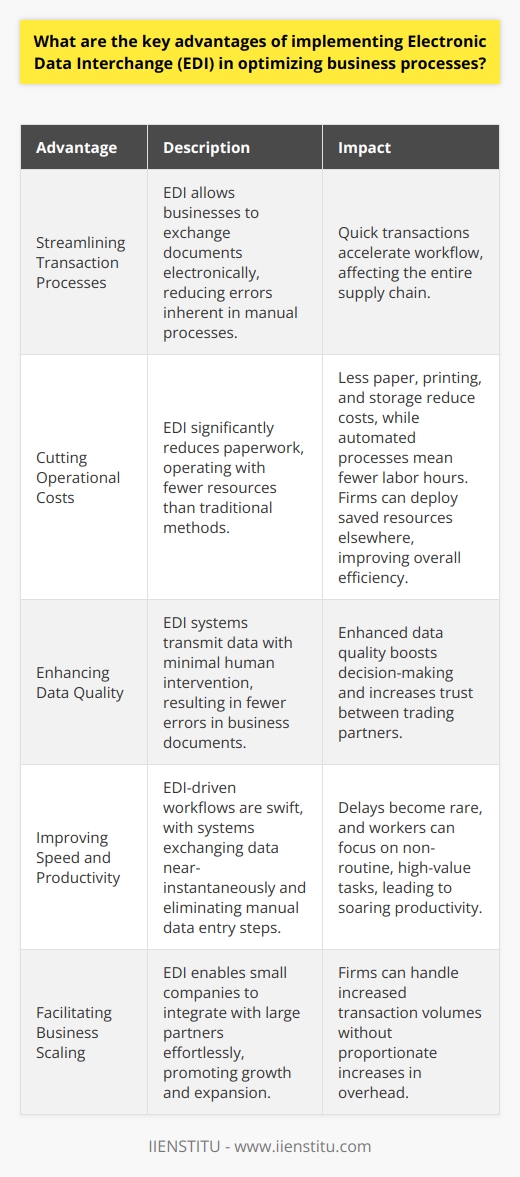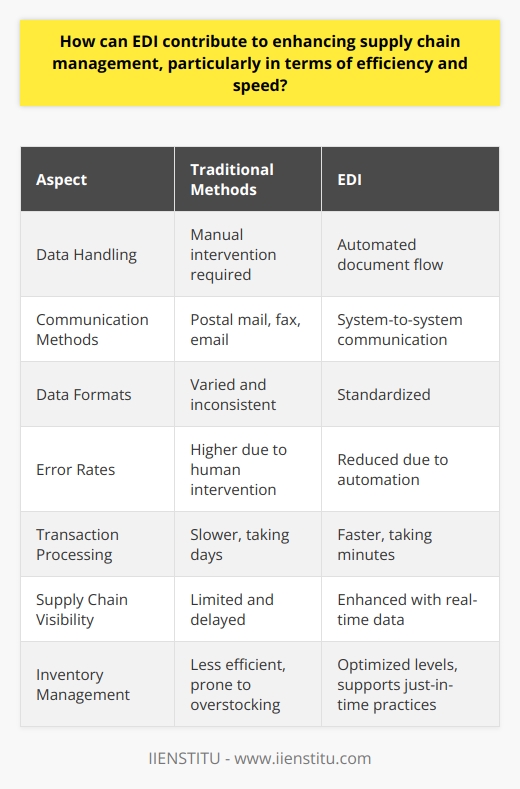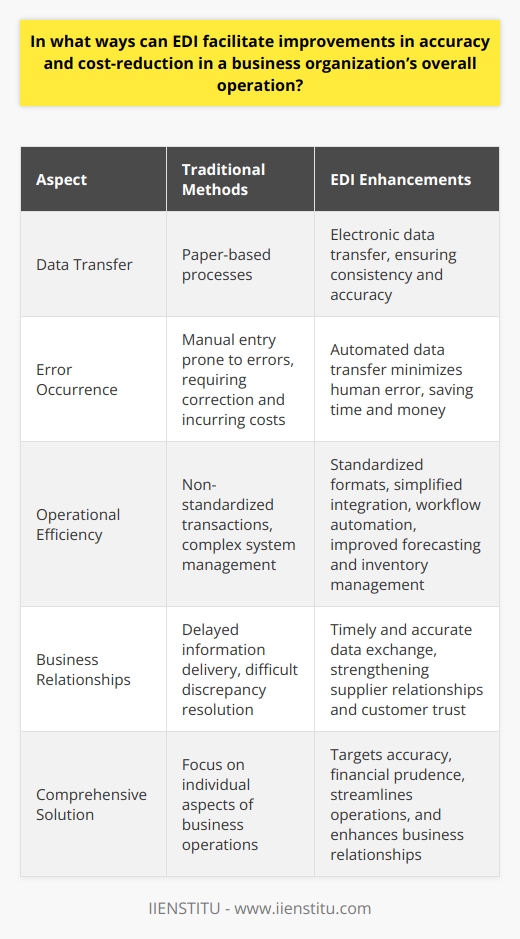In today's rapidly evolving digital landscape, the seamless transfer of business data is crucial for maintaining a competitive edge. Electronic Data Interchange (EDI) is the computer-to-computer exchange of business documents in a standard electronic format between business partners. By replacing mail, fax, and email, EDI allows companies to process transactions with greater speed, accuracy, and efficiency. EDI has been instrumental in the history of commerce, with its roots tracing back to the Berlin Airlift in 1948. However, it wasn't until the 1960s that EDI began to take form as we know it today, providing a backbone for business-to-business communications (Menzlova, 2005, p. 12). This article will engage in a comprehensive assessment of EDI, exploring its mechanics, benefits, and limitations, as well as its vital role in modern technologies and how businesses can best implement it.
Explanation of how EDI works
EDI functions by providing a set of agreed standards that allows for a ubiquitous language through which computers can exchange data regardless of the internal processes of each company.
This digital conversation involves the use of standardized documents which streamline the transaction processes. These pre-defined formats ensure that companies can interpret and process data accurately and promptly, leading to more efficient business operations.
Types of EDI systems
EDI systems can vary widely, but they typically fall into several categories. Direct EDI or Point-to-point establishes a single connection between two business partners. This model ensures high levels of security and control but can be complex and costly to maintain.
EDI via Value-Added Networks (VANs) functions by transmitting data through a third-party network, which adds layers of services and reinforcement, particularly useful for businesses managing numerous partnerships. Finally, Internet-based EDI has gained popularity due to its lower cost and broader accessibility, allowing even small businesses to engage in EDI.
Role of EDI standards
Standards such as EDIFACT, X12, and RosettaNet have been pivotal in fostering universal communication protocols. These conventions dictate how data is structured and interpreted, permitting disparate systems to interface effectively.
For example, EDIFACT is widely used internationally, governing cross-border transactions, while X12 is often applied within North America, and RosettaNet caters to specific sectors, such as electronics and semiconductors.
Example of an EDI transaction in practice
An illustrative example of an EDI transaction is the purchase order (PO). A business generates a PO in their procurement system and then, through EDI, transmits this PO to their supplier. The supplier's system automatically receives and acknowledges the order, streamlining the entire procurement cycle and reducing chances for manual errors.
I remember my first encounter with EDI when I started working at a large manufacturing company. The concept seemed daunting at first, but as I delved deeper into the intricacies of electronic data interchange implementation guide, I began to appreciate its transformative power. Our company had been struggling with manual data entry errors and delays in processing orders, leading to strained relationships with our suppliers. EDI changed all that. By automating our transactions and adopting a standardized format, we were able to streamline our operations and improve our efficiency significantly.
Pros of Using EDI for Businesses
One of the primary advantages of EDI is the reduction in errors that typically occur with manual data entry. By automating transactions, businesses can expect fewer mistakes and a lowered need for corrections.
This results in a direct increase in operational efficiency, optimizing resources and accelerating turnaround times. Moreover, EDI facilitates improved business relationships through swift, accurate, and reliable transactions, fostering trust and partnership between companies.
Potential Drawbacks of EDI Implementation
Despite its advantages, EDI implementation does come with challenges. High setup cost can deter smaller businesses from adopting EDI, particularly for in-house systems that require significant investment in infrastructure and software.
Another consideration is the ongoing technical issues and maintenance since EDI systems must evolve continually to handle ever-changing business requirements, which can lead to additional expenditures. Additionally, interoperability challenges may arise when different partners use varying EDI standards or versions, complicating the integration process.
Assessment of when implementing EDI is worthwhile
For many businesses, the decision to implement EDI hinges on the volume of transactions and the need for streamlined operations. In situations where transaction volume is high and time-sensitive, the benefits of EDI can far outweigh the initial costs. For those dealing with more moderate transaction levels, utilizing a service provider or a cloud-based solution could strike the right balance between cost and efficiency.
Role of EDI in e-commerce
EDI has become a cornerstone in e-commerce, where business transactions must be quick, precise, and consistent. It enables vendors, suppliers, and distributors to synchronize their supply chains, ensuring timely deliveries and updated inventory management.
Integration of EDI with ERP Systems
Integrating EDI with Enterprise Resource Planning (ERP) systems enhances an organization's ability to coordinate its internal and external operations. This symbiosis ensures data integrity and real-time visibility across the enterprise, significantly enhancing operational control and decision-making.
Importance of EDI in supply chain management
In the realm of supply chain management, EDI's role cannot be overstated. It facilitates the synchronous movement of information alongside physical goods, offering valuable insights into logistics and reducing inefficiencies. This exchange of information is vital for just-in-time delivery models, inventory control, and forecasting, ultimately leading to improved customer satisfaction.
The future of EDI: Cloud-based EDI and AI
Looking forward, the advent of cloud-based EDI solutions offers scalable, flexible, and cost-effective alternatives for businesses of all sizes. Meanwhile, artificial intelligence (AI) is starting to play a more significant role in enhancing EDI processes, providing predictive analytics and intelligent automation to further streamline operations.
Identifying business needs and EDI goals
Before implementing an EDI system, a company must assess its operational needs and set clear objectives. These goals should be aligned with overall business strategies and include considerations of growth, customer service standards, and supply chain integration.
Selecting the right EDI system
Choices abound between an in-house EDI system and an EDI service provider. In-house solutions offer control and customization but require substantial investment and expertise. On the other hand, partnering with an EDI service provider can reduce costs and provide access to technical support and expertise, a particularly appealing approach for smaller businesses or those looking to test the waters with online courses with certificates.
Planning and executing the EDI implementation process
After determining the appropriate EDI system, the implementation process necessitates careful planning. This includes software and partner selection, system testing, and employee training. Painstaking preparation can mitigate implementation risks and ensure a smooth transition to the new system.
Tips for troubleshooting common EDI issues
A robust troubleshooting process is paramount for handling common EDI issues. Establishing clear protocols for error handling, maintaining regular contact with partners, and continuously monitoring system performance can quickly address technical hurdles that might otherwise disrupt business operations.
The Mechanics of EDI
Explanation of How EDI Works
EDI functions by providing a set of agreed standards that allows for a ubiquitous language through which computers can exchange data regardless of the internal processes of each company. This digital conversation involves the use of standardized documents which streamline the transaction processes. These pre-defined formats ensure that companies can interpret and process data accurately and promptly, leading to more efficient business operations.
Types of EDI Systems
EDI systems can vary widely, but they typically fall into several categories:
1- Direct EDI or Point-to-Point: This type of EDI establishes a single connection between two business partners. This model ensures high levels of security and control but can be complex and costly to maintain (Drummond, 2012, p. 45).
2- EDI via Value-Added Networks (VANs): This model functions by transmitting data through a third-party network, which adds layers of services and reinforcement, particularly useful for businesses managing numerous partnerships.
3- Internet-based EDI: This type of EDI has gained popularity due to its lower cost and broader accessibility, allowing even small businesses to engage in EDI.
Role of EDI Standards
Standards such as EDIFACT, X12, and RosettaNet have been pivotal in fostering universal communication protocols. These conventions dictate how data is structured and interpreted, permitting disparate systems to interface effectively. For example, EDIFACT is widely used internationally, governing cross-border transactions, while X12 is often applied within North America, and RosettaNet caters to specific sectors, such as electronics and semiconductors (Garcia-Remesal et al., 2014, p. 23).
Example of an EDI Transaction in Practice
An illustrative example of an EDI transaction is the purchase order (PO). A business generates a PO in their procurement system and then, through EDI, transmits this PO to their supplier. The supplier's system automatically receives and acknowledges the order, streamlining the entire procurement cycle and reducing chances for manual errors.
Benefits and Limitations of EDI
Pros of Using EDI for Businesses
One of the primary advantages of EDI is the reduction in errors that typically occur with manual data entry. By automating transactions, businesses can expect fewer mistakes and a lowered need for corrections. This results in a direct increase in operational efficiency, optimizing resources and accelerating turnaround times. Moreover, EDI facilitates improved business relationships through swift, accurate, and reliable transactions, fostering trust and partnership between companies (Narayanan et al., 2009, p. 870).
Potential Drawbacks of EDI Implementation
Despite its advantages, EDI implementation does come with challenges:
High Setup Cost: This can deter smaller businesses from adopting EDI, particularly for in-house systems that require significant investment in infrastructure and software.
Technical Issues and Maintenance: EDI systems must evolve continually to handle ever-changing business requirements, which can lead to additional expenditures.
Interoperability Challenges: These may arise when different partners use varying EDI standards or versions, complicating the integration process.
Assessment of When Implementing EDI is Worthwhile
For many businesses, the decision to implement EDI hinges on the volume of transactions and the need for streamlined operations. In situations where transaction volume is high and time-sensitive, the benefits of EDI in supply chain management can far outweigh the initial costs. For those dealing with more moderate transaction levels, utilizing a service provider or a cloud-based solution could strike the right balance between cost and efficiency.
I've seen firsthand how implementing EDI can transform a company's operations. In my previous role, we were dealing with a high volume of orders from multiple retailers, each with their own unique requirements. Managing these orders manually was a nightmare - we were constantly dealing with errors, delays, and unhappy customers. After much deliberation, we decided to invest in an EDI system. It was a significant upfront cost, but the long-term benefits of EDI in supply chain management quickly became apparent. We were able to automate our order processing, reduce errors, and improve our relationships with our trading partners. It was a game-changer for our business.
EDI and Modern Technologies
Role of EDI in E-commerce
EDI has become a cornerstone in e-commerce, where business transactions must be quick, precise, and consistent. It enables vendors, suppliers, and distributors to synchronize their supply chains, ensuring timely deliveries and updated inventory management.
Integration of EDI with ERP Systems
Integrating EDI with Enterprise Resource Planning (ERP) systems enhances an organization's ability to coordinate its internal and external operations. This symbiosis ensures data integrity and real-time visibility across the enterprise, significantly enhancing operational control and decision-making (Kasemsap, 2017, p. 226).
Importance of EDI in Supply Chain Management
In the realm of supply chain management, EDI's role cannot be overstated. It facilitates the synchronous movement of information alongside physical goods, offering valuable insights into logistics and reducing inefficiencies. This exchange of information is vital for just-in-time delivery models, inventory control, and forecasting, ultimately leading to improved customer satisfaction.
The Future of EDI: Cloud-based EDI and AI
Looking forward, the advent of cloud-based EDI solutions advantages offers scalable, flexible, and cost-effective alternatives for businesses of all sizes. Meanwhile, artificial intelligence (AI) is starting to play a more significant role in enhancing EDI processes, providing predictive analytics and intelligent automation to further streamline operations.
Guide to Implementing EDI
Identifying Business Needs and EDI Goals
Before implementing an EDI system, a company must assess its operational needs and set clear objectives. These goals should be aligned with overall business strategies and include considerations of growth, customer service standards, and supply chain integration.
Selecting the Right EDI System
Choices abound between an in-house EDI system and an EDI service provider. In-house solutions offer control and customization but require substantial investment and expertise. On the other hand, partnering with an EDI service provider can reduce cost of setting up EDI for small businesses and provide access to technical support and expertise, a particularly appealing approach for smaller businesses or those looking to test the waters with EDI.
Planning and Executing the EDI Implementation Process
After determining the appropriate EDI system, the implementation process necessitates careful planning. This includes:
1- Software and Partner Selection
2- System Testing
3- Employee Training
Painstaking preparation can mitigate implementation risks and ensure a smooth transition to the new system.
Tips for Troubleshooting Common EDI Issues
A robust troubleshooting process is paramount for handling common EDI transaction types and examples issues. Establishing clear protocols for error handling, maintaining regular contact with partners, and continuously monitoring system performance can quickly address technical hurdles that might otherwise disrupt business operations.
I recall an incident where our EDI system suddenly stopped processing orders from one of our major customers. It was a critical situation, as any delay in order fulfillment could jeopardize our relationship with this key client. Our IT team immediately jumped into action, following our established troubleshooting protocols. They discovered that the issue stemmed from a recent update to our customer's EDI software, which had caused a compatibility problem with our system. By working closely with our customer's IT department and our EDI service provider, we were able to quickly implement a patch and resume normal operations. This experience underscored for me the importance of EDI in modern e-commerce and the need for robust troubleshooting processes.
Throughout this article, we have immersed ourselves in the multifaceted world of EDI, exploring its functions, types, and the indelible impact it has on modern business operations. As companies continue to search for ways to become more efficient and responsive, the significance of EDI as a transactional workhorse is undeniable.
The future of EDI looks promising, with innovations such as cloud computing and AI potentially elevating its capabilities even further. It's an exciting time for businesses to consider adopting EDI to bolster their operational competencies.
As organizations face an increasingly complex and fast-paced global market, those employing EDI will likely find themselves at an advantage. In a world where timeliness and accuracy are paramount, EDI offers a proven path to heightened efficiency and strategic business alliances.
Therefore, companies, large and small, should weigh the benefits of EDI and rightfully contemplate its implementation within their ever-evolving business models. By understanding how does EDI work with ERP systems, exploring the differences between EDI standards X12 vs EDIFACT, considering the cost of setting up EDI for small businesses, and leveraging cloud-based EDI solutions advantages, businesses can make informed decisions about their EDI strategies.
Moreover, by staying informed about tips for troubleshooting EDI errors, navigating the differences between internet EDI vs VAN EDI, and recognizing the importance of EDI in modern e-commerce, companies can ensure they are well-positioned to reap the benefits of this powerful technology.
In conclusion, EDI remains a critical tool for businesses seeking to streamline their operations, improve their relationships with trading partners, and stay competitive in today's digital age. By embracing EDI and staying attuned to its ongoing evolution, companies can unlock new levels of efficiency, agility, and growth.
References
Drummond, S. (2012). Electronic data interchange: A guide for implementation. Wiley.
Garcia-Remesal, M., Cuevas, A., Anguita, A., Borro, D., & Maojo, V. (2014). Using EDI standards to create a framework for secure and interoperable document exchange in healthcare. Journal of Biomedical Informatics, 49, 22-30. https://doi.org/10.1016/j.jbi.2014.02.012
Kasemsap, K. (2017). The role of electronic data interchange in the supply chain integration. In Advanced methodologies and technologies in business operations and management (pp. 226-238). IGI Global. https://doi.org/10.4018/978-1-5225-3924-0.ch016
Menzlova, N. (2005). History of electronic data interchange. European Central Bank.
Narayanan, S., Marucheck, A. S., & Handfield, R. B. (2009). Electronic data interchange: Research review and future directions. Decision Sciences, 40(4), 869-881. https://doi.org/10.1111/j.1540-5915.2009.00256.x








